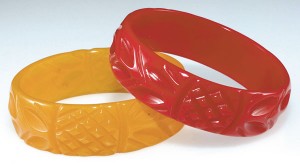We all have them. Those things that have been stored in the back of the closet or the bottom of the cedar chest, that we haven’t wanted to pitch, but we never use. A common denominator among many women is that box of jewelry from childhood that is just taking up space. As you sort through and thin down, be on the lookout for plastic jewelry that appears to be of no value. It may be a very collectible form of early 20th Century plastic know as Bakelite.
Bakelite, sometimes called Catalin or Marblette, was the first plastic used in the manufacture of jewelry from 1920-1940. Produced in a variety of colors, it is most often found in shades of white, green, brown or red. Bracelets, earrings and broaches are all highly collectible as are handbags either made entirely of Bakelite, or with handles made from the popular plastic.
First discovered by Belgian chemist Dr. Leo Baekeland in 1907, the true wonder of Bakelite is that it would not melt, even under extreme heat. It’s durability comes from its chemical makeup which is a combination of carbolic acid and formaldehyde. With the exception of altering in color, many of the pieces made nearly 100 years ago are still in mint condition. This wealth of Bakelite jewelry and the many differing styles that are available from this 100 year age span make it a perfect collectilbe. It is both easy to find and in most cases relatively affordable online and at area shops…and for the careful shopper it does surface occasionally at flea markets and garage sales for a fraction of retail.
Bakelite and newer plastics appear to be one in the same to the untrained eye, but there 3 easy test you can use. 1. The “sniff” test. Bakelite has a very strong and unpleasant odor when heated with very hot water. 2. The “hot pin” test. This is done by heating a needle over an open flame and then trying to penetrate the plastic. If it is Bakelite it will NOT penetrate. Use caution when doing this test and select a very inconspicuous spot. 3. The “Formula 409” test, which most jewelry experts consider the most accurate, is performed by dipping a Q-tip in 409 cleaning solution and touching the tip to the piece of jewelry. If the Q-tip turns yellow then the piece is genuine.
When the original Bakelite patent expired in 1927, the rights to production were acquired by the Catalin Corporation. Mass production began in that year under the Catalin-Bakelite name resulting in the manufacturer of nearly 70 percent of all phenolic resins that exist today. Catalin sold their higher-end jewelry to department stores like Saks Fifth Avenue and Bonwit Teller. Lesser pieces were produced for Woolworth’s and Sears. Watch for original tags, boxes, or receipts that may add to the value of your pieces.
The manufacture of Catalin-Bakelite ceased in 1942 as the factory turned attention to the war effort. By the time the war ended, new technologies in the field of molded plastic and the changing taste of the public made it impractical to resume production and the era of Bakelite ended. Until next time . . . . Linda
Linda Kennett is a professional liquidation consultant specializing in down-sizing for seniors and the liquidation of estates and may be reached at lkennett@indy.rr.com or 317-258-7835



